CHANTILLY, VA – Greg Nesbitt, Pleasant Valley Golf Club’s General Manager, uses a clever analogy to describe his golf facility: “We’ve always considered this property as ‘low hanging fruit’ – it’s just there for the taking, and all it needs is a little tender-loving care to keep it where it should be. That’s what we plan on doing, and more than anything, we’re striving to pay attention to detail and improve playing conditions until we’re satisfied.”
What golfer could ask for more, and it’s nothing less than the property deserves. After all, Pleasant Valley was pegged from the outset to become Fairfax County’s crown jewel for public golf facilities. Set on a huge, virtually undisturbed tract of land just south of Dulles Airport, the course was destined to become golf’s paradise island in a sea of new development engulfing the surrounding area.
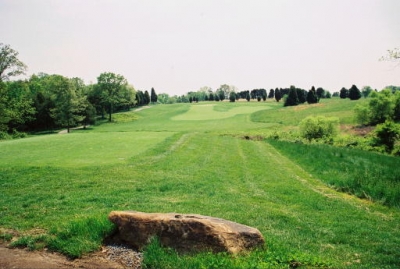 |
| Pleasant Valley's par three 3rd hole has no bunkers -- but at over 220 yards, there's still plenty of challenge. |
From the very beginning, the County’s insistence on a hundred foot tree barrier bordering the property would ensure that no residential, commercial or industrial structures would physically impinge on its finely manicured fairways. Just about the only clue to indicate there was such a thing as the outside world would be the planes making final approach to the airport.
Unfortunately, things weren’t always this way. When Pleasant Valley first opened in May of 1998, course conditions met the players’ lofty expectations – but took a steep journey down the wrong path in its first two years. A couple seasons into its young existence management changes and issues made for turning a once bright shining star into an ugly eye-sore indeed.
This kind of low-hanging fruit was infested with insects and rotting on the vine. When I first saw the course (in August, 1999), I swore I’d never go back. Luckily for me (and others with similar impressions), we decided to give it another shot a couple years ago (2002).
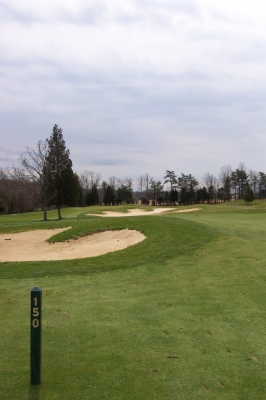 |
| Pleasant Valley's par five 5th hole presents numerous options. Here, at the 150 yard pole, shoot for the center of the green. |
Nesbitt and his group took over in 2000, and they’ve been making enhancements ever since. Having visited the course again a few weeks ago (April, 2004), it’s easy to see that the greenery is much improved from several summers ago.
But they’re still not satisfied: “We’re starting to see things green-up the way we’d like to see them,” Nesbitt said. “But it’s been a real challenge the last two years. We came out of 2002 in great shape, but the weather’s been tough on us since that time. First there was the cold, snowy winter of 2003, then last summer’s never-ending rain, then another tough winter this year.”
Needless to say, it’s been a burden to the bottom-line, but it hurts in other areas, too: “Some things we’d intended to do just got pushed back because of it. We’ve been really pleased with the weather thus far in 2004, and I think with a little luck, we’ll be in ‘A’ condition by Memorial Day,” Nesbitt added.
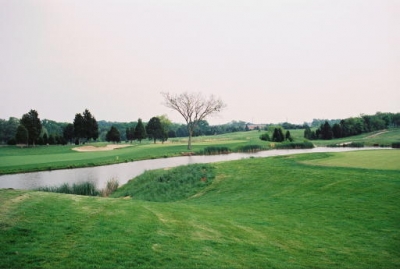 |
| A large, dead tree protects the right side of the short par five 10th. |
In order to earn the highest grade, the new Superintendent, Steve Zarnick, will have to be on his game. But Nesbitt says Zarnick’s done nothing but good things since starting in February, including mapping out a game plan to get the course to where it needs to go by the beginning of the summer season.
Projects include reworking the greenside bunkers – edging, redefining and adding some sand. “That’s the biggest problem right now, the fact our greenside bunkers are fairly inconsistent,” Nesbitt said. “They still drain extremely well, though with a few years of wear, they certainly require some attention.”
It’s always refreshing when you’re able to look at yourself and see what needs to get better – why paper over something that’s in need of repair? You won’t get the patches at Pleasant Valley, just the plain truth. Nesbitt will make sure of it.
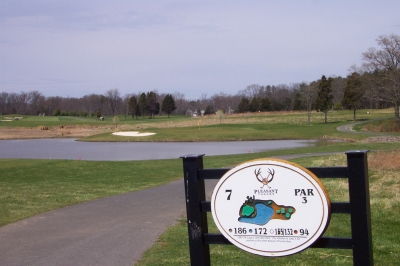 |
| The par three 7th hole isn't an island, but there's a sizeable body of water between tee and green, nonetheless. |
Additional work includes sanding and sodding a few of the fairways and in a couple months, getting a brand new cart fleet to replace the current group. It’s the type of work you’ll barely notice while it’s going on, but once it’s done, will sharpen the edges on conditioning we demand in this highly competitive golf market.
Tom Clark, the course’s designer, is gratified his creation is coming around, because he’s extremely proud of the layout. It was a rare chance for him to design a course just for the game itself: “Pleasant Valley was one of the very few opportunities architects get where you just have a golf course, and you’re buffered all around it -- so you’re right in the middle of Fairfax County and you don’t even know it. It was fun to create something just for golf, and not have to worry about housing offsets or what needs to go where.”
Because the property was so large, Clark says his firm was able to blend in all the design goodies he likes to incorporate when sketching out a course. “It basically involves returning nines -- the correct orientation of the starting and finishing holes so you’re not starting into the sun and then finishing into the sun.
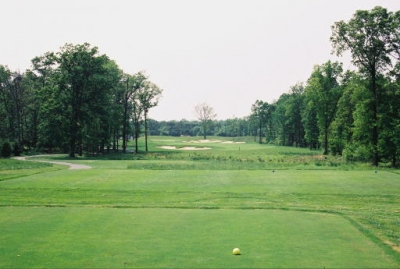 |
| Lay-up or go for it on the short par four 9th? Risk-reward all the way. |
“We were able to offer a good par four mix of all different lengths. We have a couple that are driveable (or close to it), and one that’s 479 yards (from the back tees, of course). We also have three par fives that are pretty reachable, and one that’s not. So we got our assortment of par threes, fours and fives into the blend — dogleg lefts, dogleg rights. We integrated all these different features at Pleasant Valley.”
And it terms of layout, there’s no doubt Pleasant Valley ranks well with the best in the area. Tom Clark certainly took advantage of the opportunity to spin a web of variety. As he stated above, there’s a lot of variance to challenge golfers of all abilities. Clark mixed in some bunker-less holes to contrast some links with huge bunkers. Some beastly long holes (a 596 yard par five and a 479 yard par four) and some short (a 329 yard par four and a 152 yard par three) ones. Some holes where water’s very much in play, and others where you could roll the ball the entire length to the green. Add in trees and wetlands and you have a pretty complete golf course.
Clark thinks even the hole sequencing came out well. “We started the course with two par fours and a five before getting to a par three — something we always try to do — mix in some variety. The fourth is a 222 yard par three with no bunkers. You shoot over a small valley and there’s a split fairway down where most people tend to miss it on the right. Visually, I think the fourth’s got a really good green — it’s well set up.”
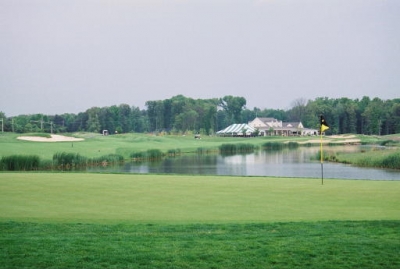 |
| From the green of the par four 17th hole, there's a lake to the right and the clubhouse in the distance. |
Nesbitt says number five is one of his favorites, and I’d have to add my vote for that one, too. It’s a 545 yard par five with an uphill tee shot, bunker on the right and a waste area on the left. The second shot presents a multitude of choices. There’s a split fairway for the layup option, with the more desirable (better angle for the third shot) left hand side a more difficult shot, because it flirts with trees and a bunker. The right side option leaves a third shot over a massive bunker to reach the green. If you go for it in two, you’ll have to clear the trees and the bunker in the center of the split. A great hole.
Nine plays to 329 yards, and is often downwind. Every part of your devilish side coerces you to rip the cover off the driver and make a big swing to get it nearer the green. Smart play is a mid to long iron to avoid a bunker and trees on the left side for a short iron approach to the tricky green. The tee shot definitely depends on which personality you take with you to the course that day.
The great mix of holes continues on the back, highlighted by a particularly interesting closing sequence. Sixteen measures 333 yards from the tips and dares you to take a driver to the green. The tee box is elevated, but there’s a huge bunker straight away, trees and wetlands to the right. Reaching the green isn’t realistic for most of us, but there’s a narrow neck that’ll allow for a short pitch to the putting surface if you place the drive right.
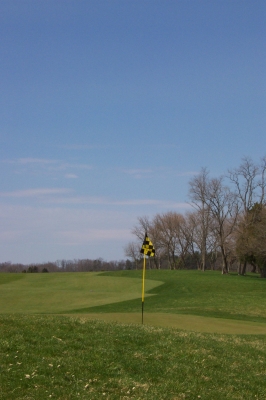 |
| From the back tees, the par four 12th hole is more like a par five -- but it's more manageable from farther forward. |
Seventeen features a huge bunker bisecting another split fairway. There’s a lake to the right side of the green — so if you choose the right hand option, you’ll have a shorter shot into the green but will bring more of the lake into play. Left is safer, but it’ll be a longer second shot.
Eighteen will rattle your driving nerves for the final hole — because the same lake influencing your thinking on seventeen guards the entire right hand side of eighteen. Slicers beware. If you drive safely, you’ll have a short to mid-iron to reach the long and narrow green protected by bunkers and water to the right and mounds to the left.
Nesbitt says the experience he’d like visitors to take away from Pleasant Valley is one of relaxation and variety. “I want our golfers to enjoy every golf hole they play — to leave our place thinking there wasn’t one hole that’s just like another.”
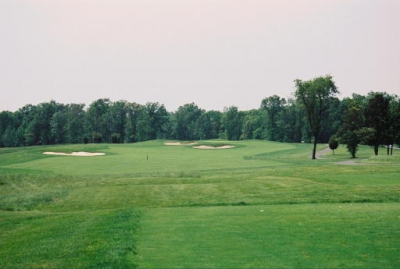 |
| There's all the room in the world to drive the ball on the par four 8th hole, but up nearer the green you'll need to be much more precise. |
Well, in that regard Nesbitt and Clark can sleep easily at night. Along with its sister course in the nearby South Riding development, members and daily fee players have a couple excellent golf choices just a short drive from busy business districts and growing residential neighborhoods.
Almost makes you want to harvest the fruit from the tree – go ahead, they won’t mind at all.
Note: See links below for information on South Riding, Tom Clark, and nearby Westfields Golf Club.
Details:
Pleasant Valley Golf Club
4715 Pleasant
Phone: (703) 631-7904
FAX: (703) 631-7906
Golf Architect: Tom Clark, Principal, Ault, Clark & Associates: www.acagolf.com
General Manager/Head Golf Professional: Greg A. Nesbitt
Superintendent: Steve Zarnick
Website: www.pleasantvalleygc.com
Tees/Yardage/Slope/Rating:
Gold: 6915/136 73.1
Blue: 6509/130 71.0
White: 5861/125 68.1
Red: 5106/118 68.9
Rates:
M-F: $64. Weekends & Holidays: $79
Weekends & Holidays after 12: $64
Twilight after 2, every day: $52
Twilight after 4, every day: $39
Junior and replay rates available. Consult the website.
All prices include cart (equipped with GPS system) — unrestricted walking allowed, but no pull carts.
Player’s Pass Program includes privileges at
| Related Links | Comments on this article? | |
|
Maryland National Golf Club Hollow Creek Golf Club Rocky Gap Resort PB Dye Golf Club in Ijamsville Whiskey Creek Golf Club |
E-mail Jeff Rendall, Editor: jrendall@golftheunitedstates.com |











